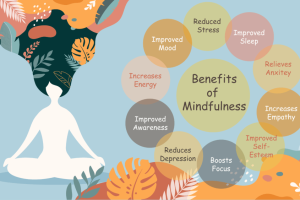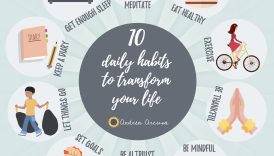Transforming Your Life Through Mindful Health Practices

Understanding Mindful Health Practices
In today’s fast-paced world, many individuals often find themselves overwhelmed and disconnected from their own well-being. Mindful health practices offer a pathway to reconnect, emphasizing awareness and presence in daily activities. For instance, consider Sarah, a busy marketing executive. She became aware of her mindless eating habits—grabbing snacks on the go and eating lunch at her desk without truly savoring her food. By inviting mindfulness into her meals, she discovered a profound change: her enjoyment of food increased, and she felt more energized. Mindfulness isn’t just about eating; it’s a comprehensive approach that can be applied to various aspects of life, including:
- Transforming Your Life Through Mindful Health Practices
- Understanding Mindful Health Practices
- Benefits of Mindful Eating
- Developing a Mindful Eating Routine
- Importance of Mindful Exercise
- Implementing Mindful Movement
- Enhancing Sleep Through Mindfulness
- Creating a Bedtime Ritual
- Mindfulness and Stress Management
- Practicing Meditation Techniques
- Cultivating Emotional Well-being
- Incorporating Mindful Breathing Exercises
- Mindful Practices for Mental Clarity
- Engaging in Mindful Thinking Strategies
- Building Healthy Relationships Through Mindfulness
- Communicating Mindfully
- Mindful Time Management for Productivity
- Using Mindful Planning Techniques
- Holistic Wellness Through Mindfulness
- Integrating Mindful Practices in Daily Life
- Mindful Eating: Appreciating each bite and recognizing hunger cues.
- Mindful Exercise: Paying attention to the body during workouts, enhancing the connection to movement.
- Mindful Sleep: Fostering a restful environment and relaxation before bed.
By adopting these mindful health practices, individuals can experience improved overall well-being and a renewed sense of balance.
Benefits of Mindful Eating
Developing a Mindful Eating Routine
Having explored the fundamentals of mindful health practices, let’s delve into the specific benefits of mindful eating. It’s fascinating how a simple shift in focus can transform the way we experience food. Imagine enjoying your meals fully instead of rushing through them—this is where mindful eating comes into play. To illustrate, consider Mark, who used to eat lunch while scrolling through his phone. By dedicating time to eat mindfully, he noticed he was not only savoring the flavors but also feeling fuller and more satisfied. To develop a mindful eating routine, consider these tips:
- Eliminate Distractions: Turn off the TV and put away your phone to create a focused environment.
- Engage All Senses: Pay attention to the colors, textures, and smells of your food.
- Chew Slowly: Aim to chew each bite thoroughly, allowing the flavors to develop and enhance satisfaction.
- Reflect on Hunger: Before eating, ask yourself if you’re truly hungry or eating out of habit.
By adopting these practices, individuals can enhance their relationship with food and usher in a deeper sense of awareness at mealtime.
Importance of Mindful Exercise
Implementing Mindful Movement
Continuing from the benefits of mindful eating, the concept of mindfulness can also significantly enhance our exercise routines. Mindful exercise encourages a deeper connection with our bodies, helping us to appreciate the movements we make and the progress we achieve. Take Lisa, for example. She used to view her workouts as a chore, often pushing through them with her mind elsewhere. By incorporating mindful movement, she began to focus on her breath, form, and how her body felt during each session. This shift allowed her not only to enjoy her workouts more but also to avoid injuries by listening to her body’s signals. To implement mindful movement in your routine, consider these strategies:
- Breathe Deeply: Focus on your breath as you move, allowing it to guide your pace and intensity.
- Connect with Your Body: Pay attention to how each part feels during exercise, whether it’s the stretch in your muscles or the rhythm of your heartbeat.
- Slow Down: Whether you’re running, dancing, or practicing yoga, deliberately slow down to engage fully with each motion.
By embracing these mindful movement practices, individuals can transform their exercise experiences into joyful and fulfilling parts of their day.
Enhancing Sleep Through Mindfulness
Creating a Bedtime Ritual
Building on the importance of mindful exercise, let’s shift our focus to another essential aspect of well-being: sleep. Quality sleep lays the foundation for a healthy body and mind, and mindfulness can significantly enhance this process. For instance, Rachel struggled with insomnia and found it hard to switch off after her busy days. By creating a bedtime ritual grounded in mindfulness, she began to experience better sleep. The key is to signal to your body that it’s time to wind down. To create an effective bedtime ritual, consider these tips:
- Set a Consistent Schedule: Go to bed and wake up at the same time every day to regulate your body’s internal clock.
- Limit Screen Time: Turn off screens at least an hour before bed to reduce blue light exposure.
- Practice Relaxation Techniques: Incorporate calming activities such as reading, gentle stretching, or deep-breathing exercises.
- Create a Soothing Environment: Dim the lights and ensure your sleeping space is cool, quiet, and comfortable.
By establishing a mindful bedtime ritual, individuals can cultivate a peaceful transition into sleep, leading to rejuvenated mornings and a more productive day ahead.
Mindfulness and Stress Management
Practicing Meditation Techniques
Having explored the importance of sleep, let’s turn our attention to managing stress through mindfulness. In a world where stress seems to be a constant companion, practicing meditation techniques can provide a powerful tool to maintain calm and clarity. Take Tom, a software engineer who found himself increasingly overwhelmed by deadlines and demands. After experimenting with various meditation techniques, he discovered how effective they were in easing his stress. By dedicating just a few minutes each day to mindfulness meditation, he learned to observe his thoughts without judgment, allowing him to regain control over his reactions. To incorporate meditation into your routine, try these techniques:
- Guided Meditations: Use apps or online resources to follow meditation sessions that focus on relaxation and stress relief.
- Breathing Exercises: Focus on breathing slowly and deeply, counting each inhalation and exhalation to anchor your mind.
- Body Scan: Practice mindfulness by slowly bringing awareness to each part of your body, releasing tension as you go.
- Loving-Kindness Meditation: Send wishes of well-being to yourself and others, fostering compassion and reducing stress.
By embracing these meditation techniques, individuals can create an oasis of calm in their lives, leading to improved resilience in the face of stressors.
Cultivating Emotional Well-being
Incorporating Mindful Breathing Exercises
As we transition from stress management, it’s essential to focus on cultivating emotional well-being through mindfulness. One effective way to do this is by incorporating mindful breathing exercises into daily routines. Consider the experience of Emma, a teacher who often felt emotionally drained by her responsibilities. She discovered that taking just a few moments to practice mindful breathing each day significantly improved her emotional resilience. By focusing on her breath, she learned to center herself amid the chaos. To incorporate mindful breathing exercises, try these techniques:
- 4-7-8 Breathing: Inhale through your nose for four seconds, hold for seven, and exhale through your mouth for eight. Repeat several times to induce relaxation.
- Box Breathing: Inhale for four counts, hold for four, exhale for four, then hold for four again. This rhythmic pattern helps calm the nervous system.
- Natural Breathing: Simply focus on your natural breath, observing each inhalation and exhalation without trying to change it.
By making mindful breathing a regular practice, individuals can enhance their emotional well-being, providing a valuable anchor in challenging times.
Mindful Practices for Mental Clarity
Engaging in Mindful Thinking Strategies
Continuing from our exploration of emotional well-being, let’s delve into how mindful practices can enhance mental clarity. In a world filled with distractions, cultivating a clear and focused mind is more important than ever. Mindful thinking strategies can help you cut through the mental clutter. For example, Jake, a college student, frequently felt overwhelmed by assignments and information overload. By applying mindful thinking, he was able to develop a clearer perspective on his priorities and tasks. He learned to approach his studies with intention, breaking down overwhelming projects into manageable steps. To engage in mindful thinking, consider these strategies:
- Daily Reflection: Spend a few minutes at the end of each day reflecting on what went well and what could be improved. This practice fosters clarity and personal growth.
- Limit Multitasking: Focus on one task at a time, which enhances both the quality of your work and your mental clarity.
- Set Intentions: Begin each day by setting clear intentions for what you hope to accomplish, aligning your focus with your goals.
By integrating these mindful thinking strategies, individuals can sharpen their focus and boost their productivity, making everyday challenges more manageable.
Building Healthy Relationships Through Mindfulness
Communicating Mindfully
Having explored mindful thinking for mental clarity, let’s shift our focus to another crucial aspect of life: relationships. Building healthy relationships requires effective communication, and mindfulness can greatly enhance how we connect with others. Take Sarah, for instance. After experiencing frequent misunderstandings with her partner, she realized that her mind often wandered during conversations. By adopting mindful communication practices, she learned to be fully present, which transformed her interactions. To communicate mindfully, consider implementing the following strategies:
- Active Listening: Rather than thinking of your response while the other person is speaking, focus completely on what they are saying. This shows respect and fosters understanding.
- Pause Before Responding: Take a moment to reflect before you respond. This helps avoid knee-jerk reactions and encourages more thoughtful dialogue.
- Use “I” Statements: Express your feelings and needs using “I” statements, such as “I feel hurt when…” This approach minimizes defensiveness and promotes open conversation.
By practicing these mindful communication strategies, individuals can cultivate deeper, more meaningful relationships, reducing conflict and enhancing emotional bonds.
Mindful Time Management for Productivity
Using Mindful Planning Techniques
As we shift our focus from building healthier relationships to enhancing productivity, it’s clear that effective time management plays a vital role in achieving our goals. By incorporating mindful planning techniques, individuals can navigate their tasks with purpose and clarity. Consider Mark, a project manager who often felt overwhelmed by his to-do list. After adopting mindful planning, he transformed his approach to time management. He learned to prioritize his tasks based on urgency and importance, which significantly reduced his stress levels. To implement mindful planning techniques, consider the following strategies:
- Prioritize Tasks: Use methods like the Eisenhower Matrix to categorize tasks based on urgency and importance, helping you focus on what truly matters.
- Time Blocking: Allocate specific blocks of time for different tasks. This structure encourages deeper focus and minimizes distractions.
- Regular Breaks: Schedule short breaks between tasks to refresh your mind. This practice improves concentration and productivity in the long run.
By engaging in these mindful planning techniques, individuals can enhance their productivity and create a more balanced approach to managing their time effectively.
Holistic Wellness Through Mindfulness
Integrating Mindful Practices in Daily Life
As we wrap up our exploration of mindful time management, it’s essential to see how these concepts fit into a broader picture of holistic wellness. Integrating mindful practices into daily life creates a balanced approach to well-being, influencing every aspect—from physical health to emotional resilience. Take Julia, for instance. Struggling to juggle her responsibilities, she began incorporating mindful practices throughout her day. By establishing a holistic routine, she found not only improved productivity but also greater fulfillment. Here are some easy ways to integrate mindfulness into your everyday life:
- Mindful Mornings: Start your day with a few minutes of meditation or gentle stretching to set a positive tone.
- Mindful Eating: Make meals an opportunity to appreciate flavors and nourish your body, rather than rushing through them.
- Mindful Commute: Use your travel time to practice deep breathing or listen to calming music, transforming a stressful journey into a moment of peace.
- Gratitude Journaling: Take time each evening to reflect on three things you’re grateful for, fostering positivity and perspective.
By weaving these mindful practices into daily routines, individuals can cultivate a sense of holistic wellness, leading to a more balanced and joyful life.





